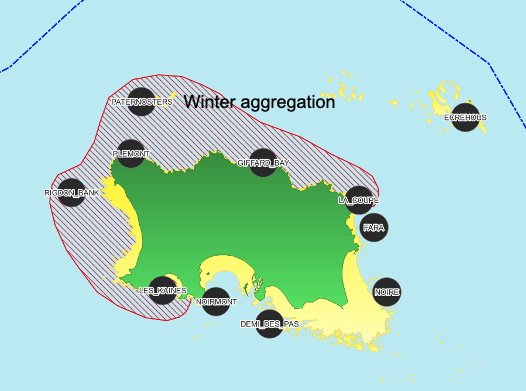


New research is starting to shed light on a shy and enigmatic resident of Jersey’s waters... the porpoise.
Far less numerous or visual than its cetacean cousin, the dolphin, the porpoise appears to frequent only certain parts of the island at certain times of the year.
Although most of the porpoise’s habits remain a mystery, ongoing research led by the Government’s Marine Resources Department is filling in some of the blanks.
Underwater listening devices – which record and measure the echolocation clicks of dolphins and porpoises – have revealed that groups of porpoises gather off Jersey from mid-December to early March.
They also limit themselves to the north and west of the island.
And when their distinctive clicks are heard, dolphin encounters are rare, meaning that – for reasons unclear – the two species do not live side by side.
Although dolphins and porpoises are both mammals, the former has a longer snout, bigger mouth and more curved dorsal fin.
There are 32 dolphin species but only six porpoise species, with the harbour porpoise found around Jersey.

Pictured: Where porpoises appear to gather from mid-December to early March. (Marine Resources Dept)
Since 2016, when the first ‘hydrophone’ was deployed, the number of devices has increased to 51 and over the last six years, there have been nearly 6,000 recorded encounters with dolphins and porpoises.
Head of Marine Resources Dr Paul Chambers said: “We can tell from their clicks that the porpoises seem to spend their entire time feeding so we can presume that the reason they’re here is for food, perhaps squid.
“The intriguing thing is, why only the north and west coasts? St. Catherine’s Breakwater is a dividing line and we’ve had hydrophones either side; the one to the north has porpoises and the one south doesn’t.
“They are very shy and more active at night so no one had ever spotted this before.
“Where they go when they’re not around Jersey is the million-dollar question. It is not in Channel Island waters as they are rarely recorded on the hydrophone network, which now covers the whole area, during the summer months.
“There are some encounters recorded during the spring and summer, but these are few and far between and last mere seconds. In the winter, we get hours and hours of continuous porpoise activity off the north and south-west coasts.”
He added: “When the porpoises are inshore, we seem to get fewer dolphin encounters. Whether this is because the dolphins and porpoises can’t coexist or because the porpoises move into areas when the dolphins go elsewhere is difficult to say.
"The hydrophone dataset probably has the answer to this, but we haven’t got to that point in the analysis yet.”

Pictured: Dolphins off Les Ecréhous. Unlike porpoises, there is a year-round dolphin population around Jersey.
Asked why this research was important, Dr Chambers said: “All cetacean species are protected locally and are considered iconic by many islanders, including our fishing community, who have helped with our various research projects.
“We have always worked with local organisations, such as the Société Jersiaise, to collect sightings and other data on our marine life but this does have its limitations.
“Since 2016, the use of seabed hydrophones has proved to be a cost-effective means of collecting robust scientific data that can be used to unlock the many mysteries surrounding our local cetaceans.
“The results have been extraordinary and include the identification of seasonal congregation sites for dolphins and porpoises and an insight into the way in which these animals behave and use individual parts of our marine environment."
He continued: “Top predators such as dolphins and porpoises can also offer insights into the health of coastal waters as their success depends on the maintenance of healthy food chains and habitats.
“Weaken any link within a food chain and it is the top predators that will suffer first. Our research and that of the GECC [Groupe d’Etude des Cétacés du Cotentin] in Normandy suggests that the dolphin population around Jersey and the other Channel Islands is stable with behaviour patterns that are consistent from year to year.
“As fisheries officers, we spend a great deal of time at sea and see dolphins regularly; even so, the magic of these majestic animals never fades, and each encounter brings with it something new and exciting.”
In spring, common dolphins tend to gather around the Paternosters and Plémont, while bottlenose dolphins aggregate more around the Minquiers;
These seasonal encounters start and finish suddenly, and individual encounters may last from several hours to several days;
General dolphin sites include the Ecréhous, Giffard Bay, La Coupe, Grouville, Noirmont and St Brèlade’s Bay;
Here, dolphins are often continuously present for a few days then absent for several days. Encounters with hydrophones are often very short, from seconds to a few months;
There were very few encounters west of the Minquiers and off the Rigdon Bank, which is west of L’Etacq. Days or weeks can pass by without any encounters.
Comments
Comments on this story express the views of the commentator only, not Bailiwick Publishing. We are unable to guarantee the accuracy of any of those comments.